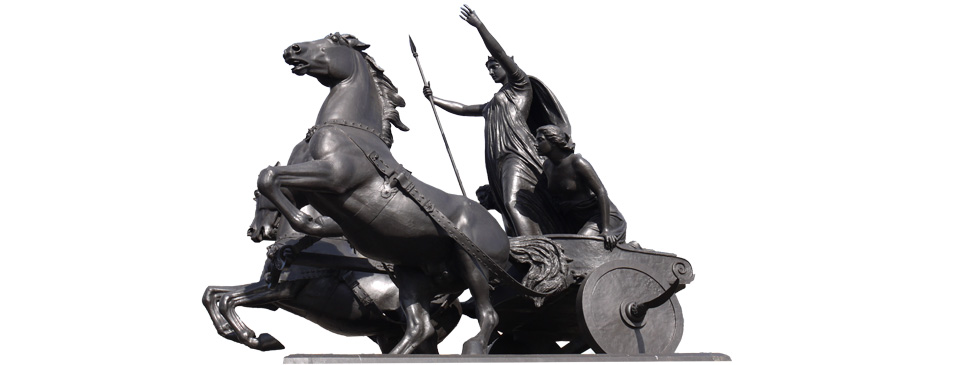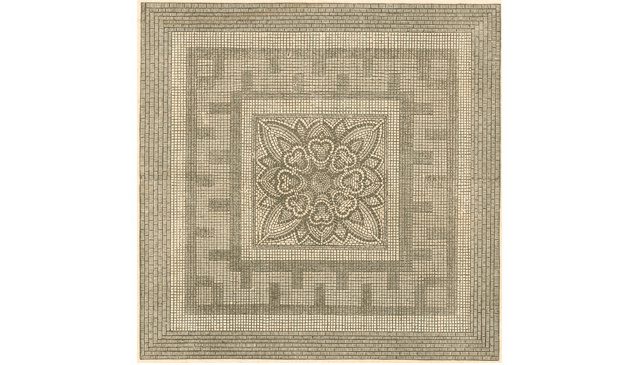The rise and fall of the first Roman town of Londinium

Thomas Thornycroft’s larger-than-lifesize statue of Boudicca on Westminster Bridge, opposite the Houses of Parliament. She gallops forward on her chariot, accompanied by two maidens, perhaps her daughters. Thornycroft started the sculpture in the 1850s, commissioned by Prince Albert who lent him two horses to assist with the depiction. Albert died in 1861 and his full-sized model was not completed until shortly before Thorneycroft’s death in 1885. It was finally cast in bronze and erected at Westminster by the London County Council in 1902.
The Roman town began as a small settlement to protect and maintain the bridge over the Thames. It soon grew into a busy town, but it was to last just 13 years before being destroyed in a major rebellion by an army of British tribes.
London began with a bridge, which we now call London Bridge. Initially it was probably a temporary military pontoon structure, quickly constructed by engineers of the invading army of the Roman Emperor Claudius to provide a dry crossing over the River Thames on their journey to defeat the local Catuvellauni tribe at their capital of Colchester.
Since the brief invasion by Julius Caesar the Catuvellauni had expanded their territory south of the Thames, overwhelming their neighbours such as the Atrebatics. In the 90 years following their previous incursion the Romans had considered bringing Britain within their empire. Finally, an appeal for help from the Atrebatics not only gave them the excuse of helping an ally but meant they could expect a welcome along the south coast, as well as from other tribes threatened by the Catuvellauni.
In 43AD Claudius dispatched at least 40,000 troops from the Continent to Kent under the command of Aulus Plautius. The Catuvellauni army was beaten back in battle, possibly near Rochester. They retreated, crossing the Thames on the west side of modern-day London, perhaps at Westminster, Battersea, Fulham or Brentford. Germanic units of the Roman legions waded across the river in pursuit and fought their opponents somewhere around Kensington or Westminster. The British were able to escape and hide in marshes, probably around Hackney or Stratford. Plautius was by then in control of the south-east of Britain and, acting on orders from Rome, consolidated his position on the south bank of the Thames, probably around Southwark. He waited there for the Emperor to arrive with reinforcements.
Emperor Claudius came with a large reserve force, together with elephants that no doubt gave a considerable fright to any Catuvellauni fighters who witnessed them for the first time. The Roman forces moved on to the main Catuvellaunian stronghold at Colchester, which the Romans took without too much difficulty. Claudius then received oaths of loyalty from eleven tribal kings, returning home after sixteen days and leaving his troops to set up the capital of the new province of Britannia at Colchester.
Having succeeded in their initial mission, the invaders, who for all their sophistication were not great sailors, needed to maintain a land supply route back to Rome via Gaul. Therefore, the bridge over the Thames stayed and was rebuilt. The Romans had found that the best location for it was just downriver of where the Thames was joined by the River Fleet. The banks of the river were quite marshy in those times and the chosen site was probably the most easterly – or downriver – point that was narrow enough for a bridge. The Thames was still deep and tidal up to that point, so boats could navigate to bring in heavy supplies from Boulogne. Fresh water was freely available from the many springs and streams, and the area was surrounded by forest that could provide wood for building. On the northern bank two small hills – Cornhill and Ludgate Hill, today occupied by Leadenhall Market and St. Paul’s Cathedral – were useful as lookout points, between which the River Walbrook flowed from its sources in what are now Hackney and Islington. Unlike the surrounding marshy riverbanks these hills provided high, dry land on which to build. It was for all those reasons that London was eventually sited where it is.
Such a strategic site needed a staff to protect and maintain it and a small settlement grew. Wharves were constructed along the riverside, allowing ships to unload. From each end of the bridge roads were laid out (often along the same routes that had existed before the Romans’ arrival), branching out in various directions to link settlements such as Rochester, Canterbury, Dover, St. Albans, Colchester, Lincoln and Chichester. (The modern London streets of Old Kent Road, Edgware Road, Holborn, Oxford Street, Bayswater Road, Fleet Street, Strand, Whitehall, Bishopsgate, Kingsland Road and others all existed at least as far back as the Romans).
The small settlement at the bridge became both a small port and the hub of the supply routes in the Roman province. Four years after their arrival the Romans formally decided to build a town on the north bank where the Walbrook stream flowed into the Thames, to be known as Londinium (a name probably based on an earlier native word or name). It was a rare example in the Roman empire of a completely new town that had not existed before their conquest and without its own territory to administer.
The first Roman Londinium was of rectangular shape of around 60 acres, of which around 30 acres was densely populated. In the centre was the forum (marketplace) enclosed by a basilica (town hall) and shops and offices. Surrounding those were warehouses and workshops along streets laid out in a grid shape. The town initially acted as a military supply centre but soon grew in importance as a trading place, importing manufactured goods and exporting slaves, tin and lead. It grew rapidly and by 60AD was estimated to have a population of between ten and twenty thousand inhabitants. As it had not existed previously, the entire population of the early town consisted of people who had migrated from other parts of the empire.
In 60 AD the native Iceni tribe in the northern half of East Anglia rebelled against the Romans. The local administrator had caused some grievances amongst the people and when their king died the Romans refused to recognise his daughters as successors. The tribe, led by the king’s daughter Boudicca, rose up and joined with others, numbering 120,000, far greater than the local Roman forces. Marching on Colchester, they destroyed the capital and then moved south-west. The main Roman army in Britannia was fighting in Anglesey and marched south as fast as they could. They did not, however, have sufficient strength to take on Boudicca’s army, which burnt Londinium to the ground, killing those who had not already fled. (The original Roman settlement can still be traced by the burnt remains that lie below more recent levels). After Londinium, the rebels moved on to St. Albans, which was also destroyed. In total, 70,000 inhabitants of Colchester, London and St. Albans lost their lives in the rebellion, which was finally quashed by the Roman forces during a major battle in the Midlands. The first Roman town of Londinium had lasted a mere 13 years.
Sources include: John Morris ‘Londinium – London in the Roman Empire’; Simon Webb ‘Life in Roman London’; Dominic Perring ‘Roman London’; Gustav Milne ‘The Port of Roman London’.
< Back to Roman London


